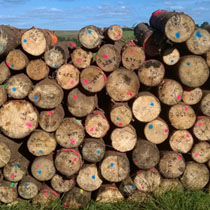Summary
Summary
This project aims to investigate the relationships between tree growth, environment and genetics on the wood properties that are crucial to both the survival of forests and the sustainable production of a range of forest products from the domestic forest resource.
Research objectives
- Provide evidence based guidance on the suitability of conifer and broadleaved species for a range of forest products
- Quantify the relationship between the growing environment and wood formation to inform how forest management practices will affect the production of forest products.
- Implementation of modern and efficient methods for measuring and continual monitoring of the wood properties of trees.
Status
The current cycle of research was initiated in 2015 and is due to last until March 2020. We have two active Work Packages with three Work Areas in each.
Measuring and Modelling Wood Properties
The key aims of these areas of research are to develop measurement techniques that will allow us to more effectively assess and monitor the national forest resource. Plus we wish to gain further insight into how trees are shaped, in a physical and structural sense, by their environment. We are focusing on tree and wood properties that are essential for productive, yet resilient (in the sense of climate) forests, in line with current and future end uses/markets. We aim to add value to all values of the forest wood chain promoting economic growth
- Measuring tree and wood properties
- Modelling tree and wood properties
- Tree biomechanics and environment
Timber properties of home-grown conifers and broadleaves
The main aim of these research areas is to address the changes in raw material supply to the forest product industries that can occur due to possible changes in planting and management strategies. Additionally we aim to investigate the ecosystem service of carbon sequestration provided by a range of tree species to inform the public and practitioners alike
- Timber properties of homegrown conifers and broadleaves
- Alternative management
- Carbon sequestration of a range of tree species
Forestry policy
The sustainable production and utilisation of British timber is a key component of the forestry strategies of England, Scotland and Wales: research in this project will produce information and tools in support of these policy objectives.
In England the Government Forestry and Woodlands Policy Statement highlighted ‘The scope for developing new markets based around a better understanding of the value and potential of our trees, woods and forests’ and the need to “increase the amount of woodland management driven by economic activity through the sustainable harvesting of wood products”.
In Scotland, the primary objective of Scotland’s Forestry Strategy 2019–2029 is to ‘Increase the contribution of forests and woodlands to Scotland’s sustainable and inclusive economic growth’. A priority of the Strategy is to ‘Improve efficiency, productivity and developing markets’, by ‘ensuring that the wood fibre availability from Scotland’s forests and woodlands is predictable and increases over time’.
The Scottish Forest and Timber Technologies Industry Leadership Group’s Roots for Further Growth: An economic strategy for Scotland’s Forest & Timber Technologies Sector to 2030 prioritises ‘maximising the economic outputs of Scotland’s forest and fibre resource’ by ‘improving the quality and quantity of wood fibre through tree breeding research’, and also to ‘expanding markets and add value’ through research to ‘obtain the best possible technical information about wood and wood-based products’ by ‘exploring and creating new and innovative wood-based value-added products, processes and markets’.
Scotland’s Timber Development Programme focuses on four objectives:
- Promote a predictable and stable timber supply.
- Encourage more use of timber and timber products
- Enable improvements to timber supply chain efficiency
- Encourage and enable improvements to the quality of the growing stock.
A stated objective of the Woodlands for Wales Forest Strategy (2018) is to deliver ‘a competitive and integrated forest sector’. Key outcomes will be that ‘more timber is grown, processed and used in Wales’ and that ‘increased use is made of timber as a key renewable resource’.
General Content
What’s new?
Wood properties and uses of Scots pine in Britain
Assessing the stem straightness of trees
Shake in oak: an evidence review
Furthering the use of English wood products in a range of markets
Defra-funded contract aimed at developing an evidence base for understanding the behavioural, cultural, physical and economic barriers which may be limiting the use of wood products.
Wood For Good
Includes building with wood: information for architects, engineers, builders etc.
Scots pine market development report (PDF-823K)
Evaluating potential new market opportunities for Scots pine timber.
Benefits of improved Sitka spruce: volume and quality of timber (PDF-534K)
Forestry Commission Research Note 3.
Related pages
Related documents
- Timber properties of noble fir, Norway spruce, western red cedar and western hemlock grown in Great Britain
- Shake in oak: an evidence review
- Assessing the stem straightness of trees
